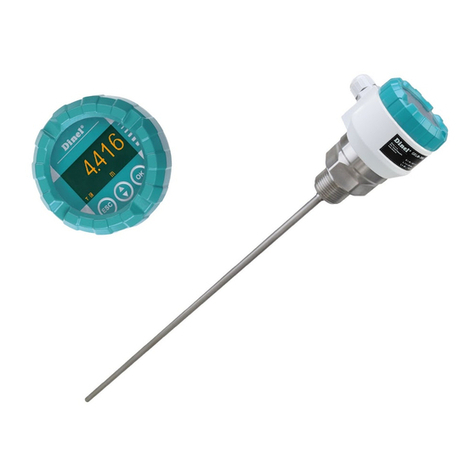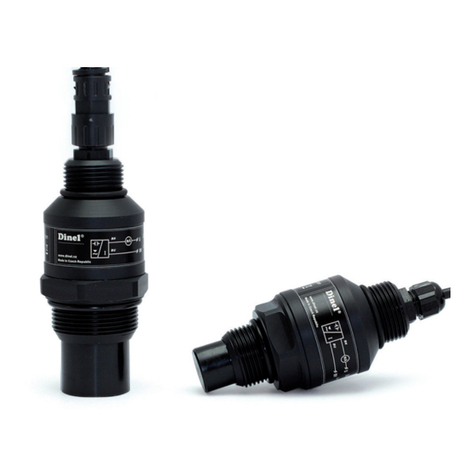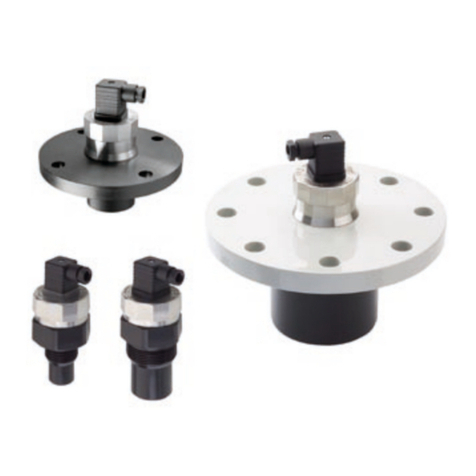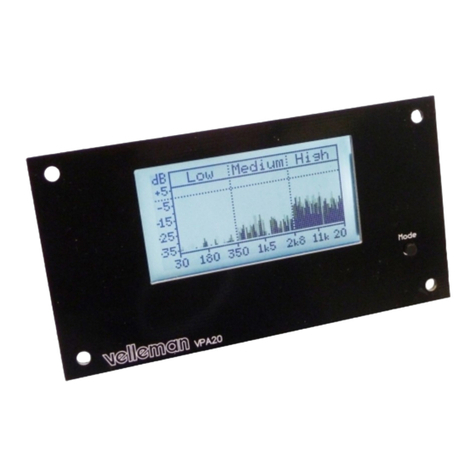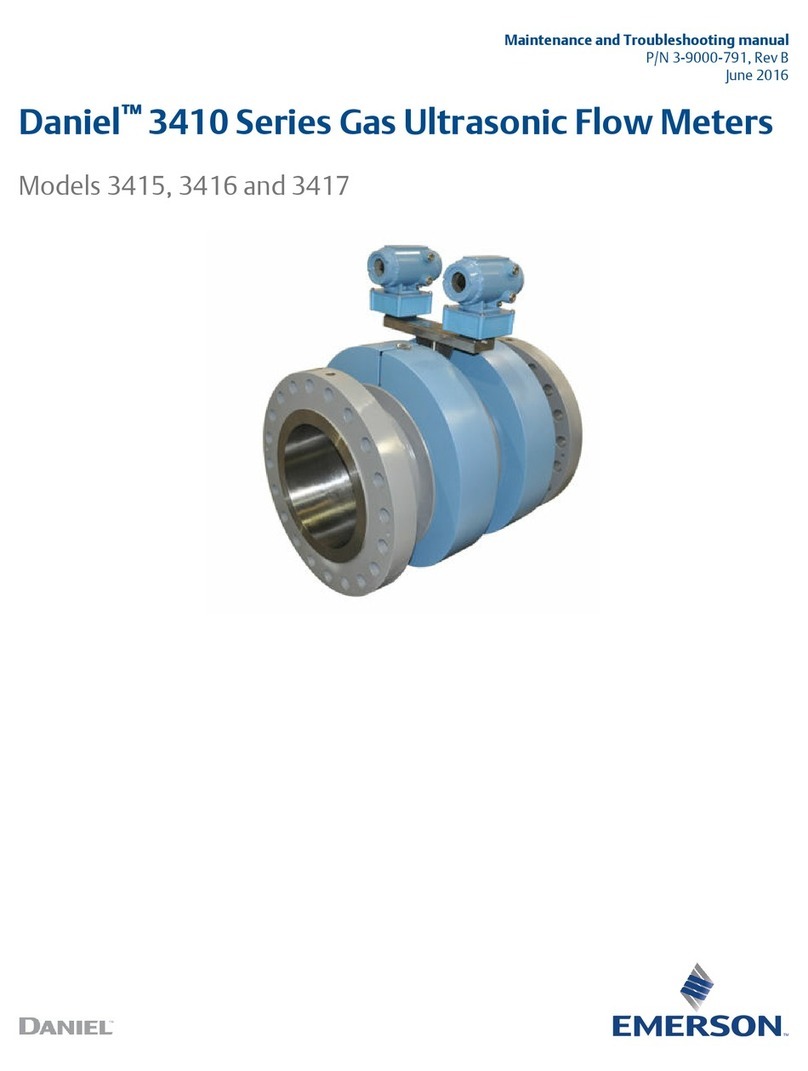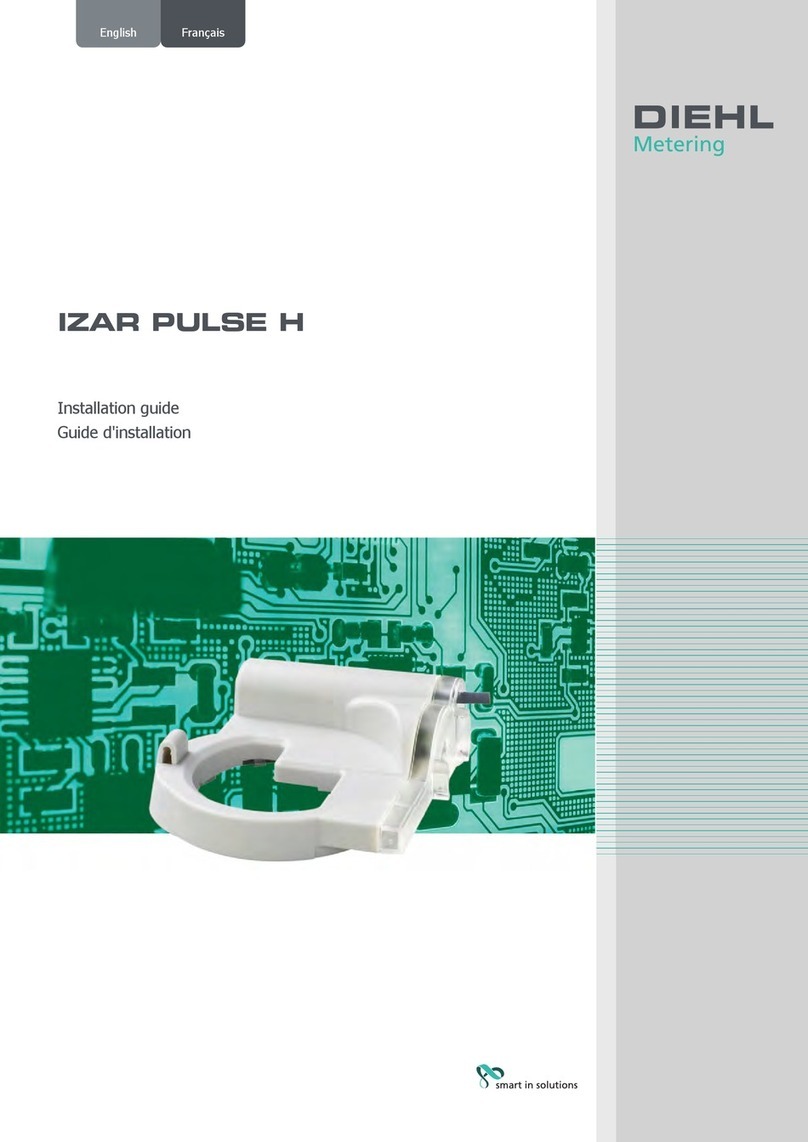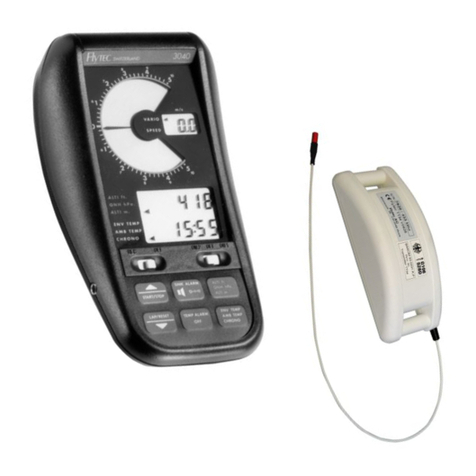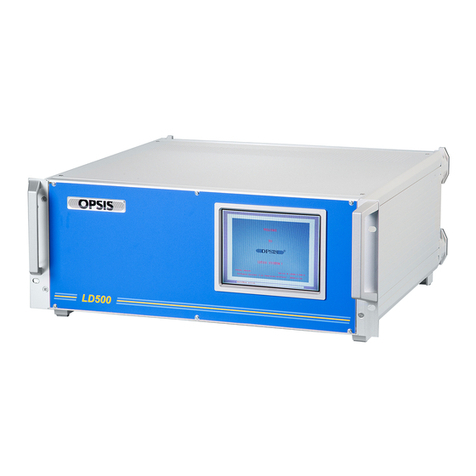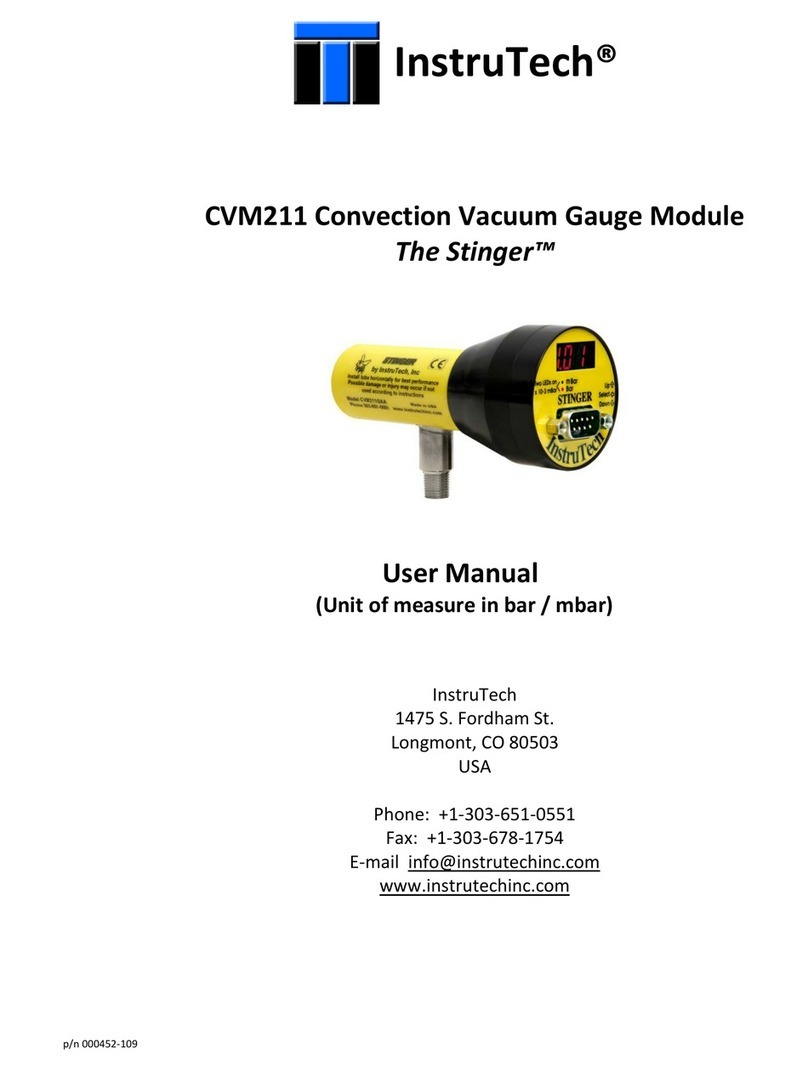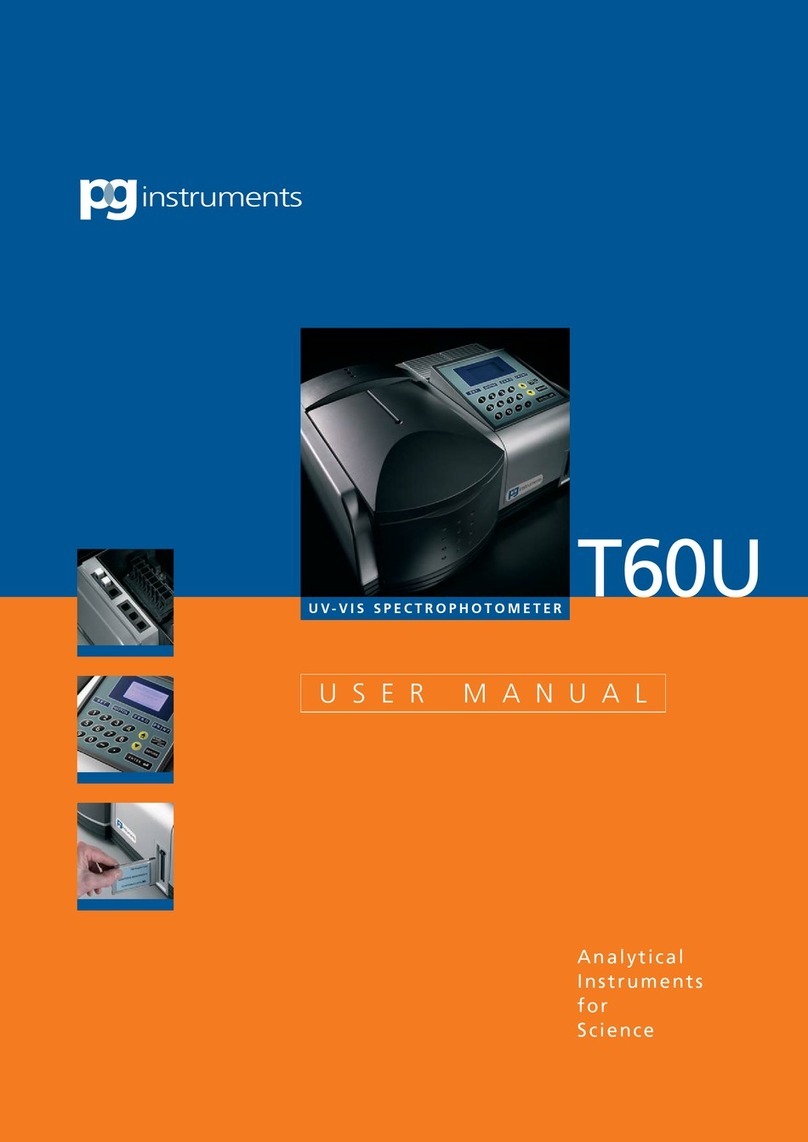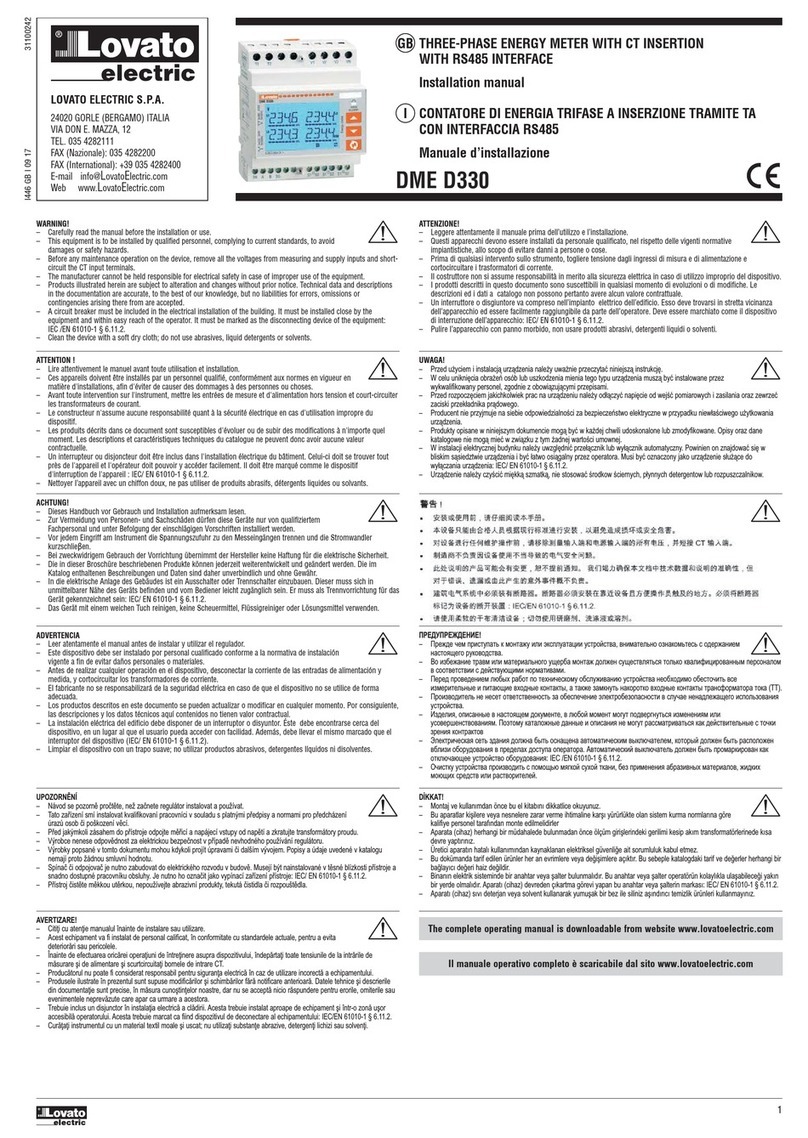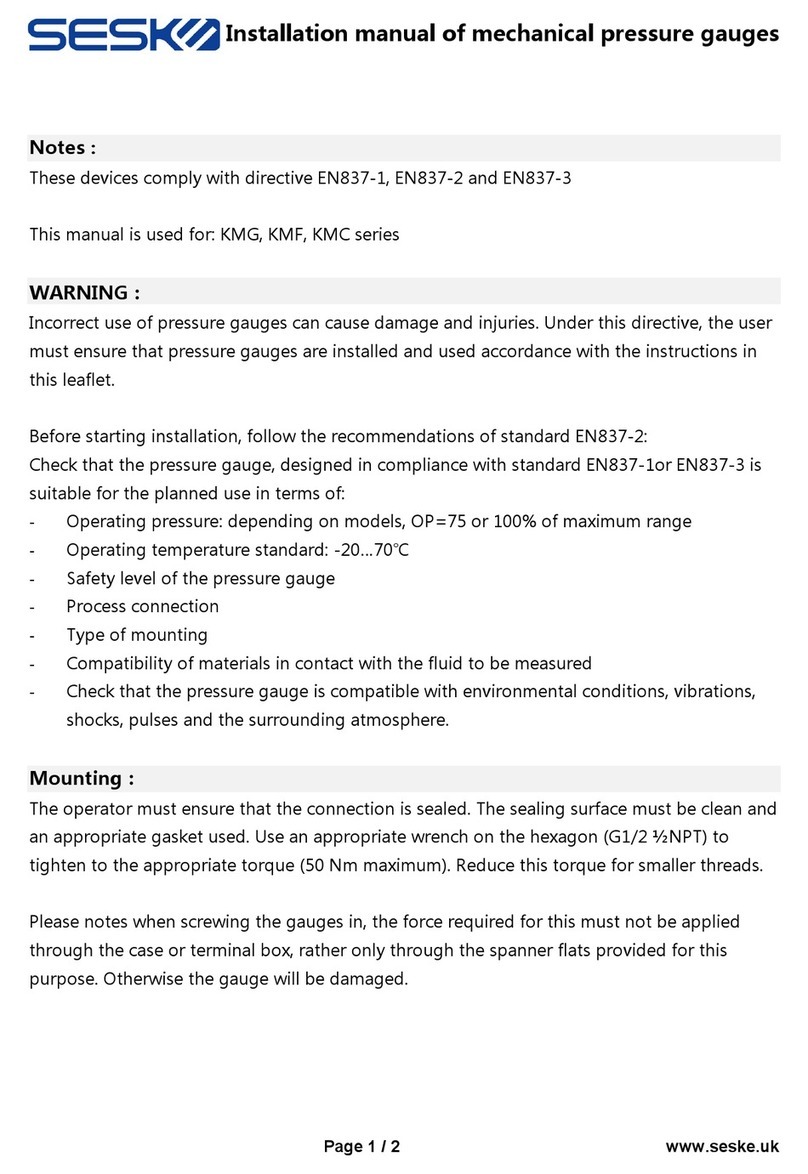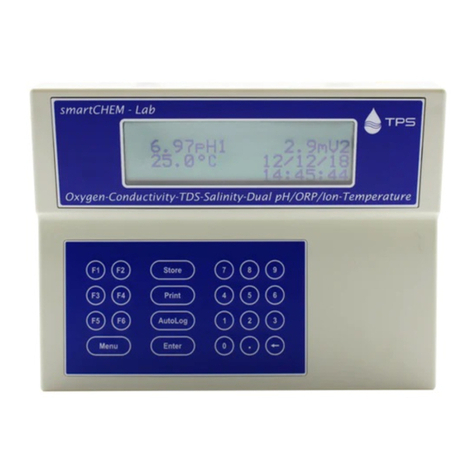Dinel CLM-36 User manual

Read carefully the instructions published in this manual before the rst use of the level meter. Keep the manual
at a safe place. The manufacturer reserves the right to implement changes without prior notice.
Capacitive level meter CLM – 36Capacitive level meter CLM – 36
INSTRUCTION MANUAL


1 . Basic description .................................................................................................................... 4
2 . Areas of application ................................................................................................................. 4
3 . Sensor variants ....................................................................................................................... 5
4 . Dimensional drawings ............................................................................................................. 6
5 . Eect of tank shape on the linearity of the measurement ....................................................... 8
6 . Commissioning procedure ...................................................................................................... 9
7 . Mechanical assembly .............................................................................................................. 9
8 . Electrical connection ............................................................................................................... 12
9 . Preparing the level meter for measurement ........................................................................... 14
10 . Settings ................................................................................................................................ 15
11 . Method of marking ................................................................................................................ 17
12 . Examples of correct labeling ................................................................................................. 18
13 . Accessories ........................................................................................................................... 18
14 . Protection, safety, compatibility and explosion proof ............................................................ 18
15 . Use, operation and maintenance .......................................................................................... 19
16 . General warranty conditions ................................................................................................. 21
17 . Labeling ................................................................................................................................. 22
18. Technical parameters ............................................................................................................ 24
19 . Relative permittivity table ...................................................................................................... 28
20 . Relative permittivity table ...................................................................................................... 29

CLM–36 © Dinel, s.r.o.
4
CLM® capacitive level meters are designed for continuous level measurement of liquid and bulk
solids in tanks, storage tanks, silos, etc. They consist of a housing with removable electronics
and a measuring electrode. The electronic part converts the capacitance value into a current
signal (4 ... 20 mA) or a voltage signal (0 ... 10 V). The sensitivity can be adjusted, the initial
capacitance can be compensated and the amplication can be changed continuously.
The level meters are available in the following versions: N - for non-explosion hazardous areas,
NT - high temperature version for non-explosion hazardous areas, Xi - intrinsically safe version
for explosion hazardous areas, XiT - high temperature version for explosion hazardous areas.
CLM are oered in variants with dierent types of process connection (threaded, Tri-Clamp).
All operations described in this instruction manual have to be carried out by trained personnel
or by an accredited person only. Warranty and post warranty service must be exclusively
carried out by the manufacturer.
Improper use, installation or set-up of the sensor can lead to crashes in the application.
The manufacturer is not responsible for improper use, loss of work caused by either direct
or indirect damage, and for expenses incurred at the time of installation or during the period
of use of the level sensors.
To ensure the maximum safety of management processes, we have dened the following safety and infor-
mation guidelines. Each instruction is marked with a corresponding pictogram.
This symbol informs you about particularly important instructions for installation and operation of
equipment or dangerous situations that may occur during the installation and operation. Not observing
these instructions may cause disturbance, damage or destruction of equipment or may cause injury.
This symbol indicates particularly important characteristics of the device.
This symbol indicates helpful additional information.
Capacitive level meters are suitable for continuous level measurement of a wide variety of liquids
and bulk materials. The level meters are resistant to all changes in the atmosphere above the
surface (vacuum, overpressure, vapour, dust).

5
© Dinel, s.r.o. CLM–36
• CLM–36_–10 Non-insulated rod electrode, for measuring the level of electrically non-
conductive liquids (oil, diesel, gasoline) and bulk solid materials (our, sand,
cement, plastic granules, etc.).
Electrode length from 0.2 m to 5 m (for materials with low permittivity εr <10,
the minimum electrode length is 0.5 m).
• CLM–36_–11 Insulated rod electrode (PFA), suitable for measuring the level of water and
other electrically conductive liquids. Also suitable for contaminated liquids in
metal tanks, concrete pits, etc.
Electrode length from 0.2 m to 3 m.
• CLM–36_–12 Insulated rod electrode (FEP), suitable for measuring the level of water and
other electrically conductive liquids. Also suitable for contaminated liquids in
metal tanks, concrete pits, etc.
Electrode length from 0.2 m to 3 m.
• CLM–36_–20 Non-insulated rod electrode with reference tube, to measure the level of
unpolluted and electrically non-conductive liquids (oil, diesel, gasoline).
Electrode length from 0.2 m to 3 m.
• CLM–36_–22 Insulated rod electrode with reference tube, for measuring the level of
clean electrically conductive liquids (e.g. in plastic and glass tanks) and for
greater demands on measurement accuracy. Electrode insulation made of
FEP material. Electrode length from 0.2 m to 3 m.
• CLM–36_–30 Non-insulated stainless steel rope electrode and weights, for measuring
the level of loose materials (sand, our, cement, etc.) Possibility of shortening
the rope. Electrode length from 1 m to 20 m.
• CLM–36_–31 Non-insulated stainless steel rope electrode and insulated dynamic
anchorage, to measure the level of bulk materials in higher silos.
Electrode length from 1 m to 20 m.
• CLM–36_–32 Insulated rope electrode (FEP) with insulated weight (FEP), designed to
measure the level of electrically conductive and non-conductive liquids.
Electrode length from 1 m to 15 m.

CLM–36 © Dinel, s.r.o.
6
CLM–36_–30
34
100
91
125
34
34
34
100
91
125
34
34
CLM–36_–10, 11, 12 CLM–36_–20, 22
* thread types: M36x2; G1"
** for materials with low permittivity (εr <10) is
minimum electrode length E500
34
100
91
125
34
34
thread *
high temperature design
CLM–36_T
34
100
91
125
34
34

7
© Dinel, s.r.o. CLM–36
34
100
91
125
34
34
connection **
34
100
91
125
34
34
E1000 ... E15000
152
4
ø
18
ø
CLM–36_–32 CLM–36_–31
34
100
91
125
34
34
rope
electrode
tank wall
(KV–31, PR–31)*
compression spring
anchor
with a ball joint
Tri-Clamp process connection
* anchoring roller KV–31 or dustproof
bushing PR–31 (see accessories)
** connection types: Tri-Clamp CI50 (ø 50.5 mm)

CLM–36 © Dinel, s.r.o.
8
• For curved containers (most often a horizontal
cylinder), the change in capacity when measuring
electrically non-conductive substances is non-linear.
• Linearization is performed using a concentric
reference tube (CLM – 36_–20, 22).
• For a tank with a straight wall and a probe placed
parallel to it, the capacity change is linear.
VALID FOR: CLM-36_-10, 11, 12
CLM-36_-30, 31, 32
VALID FOR: CLM-36_-20, 22
VALID FOR: all types

9
© Dinel, s.r.o. CLM–36
• Level meters with an insulated electrode are equipped with a protective cap at the end of the electrode,
which must be removed before assembly.
• The level meters are mounted in a vertical position in the upper lid of the tank or reservoir, for example,
using a steel weld ON-36x2 (steel 11375), a stainless steel weld NN-36x2 (stainless steel 1.4301),
a fastening nut UM-36x2 (stainless steel 1.4301) or a Clamp-type ange.
• When mounting the level meter in a metal tank or reservoir, it is not necessary to ground the housing
separately.
• In the case of installation in concrete pits or silos, it is advisable to install the level meter on an auxiliary
metal structure (console, lid, etc.) and then connect it to a metal object that is constantly submerged, or
with steel reinforcements in concrete (reinforcement).
• When measuring the level of substances in plastic or glass containers with a level meter without a
reference tube, it is necessary to connect the grounding screw on the sensor head with an auxiliary
electrode, which is xed in a suitable way to the outer shell of the container (or to the inner wall). The
material of the auxiliary electrode should be chosen taking into account the working environment and the
properties of the substance to be measured.
E- electrode length [mm] - choose so that the
end of the electrode is immersed at least 20
mm below the lowest measured level
h- distance from the bottom - at least 50 mm
a- distance from the wall - at least approx. E/20
d- diameter of tubular auxiliary container - at
least 40 + E/20 (smaller dimensions need to
be discussed)
auxiliary electrode
width = min. 30 mm
(required only
for non-metallic
containers)
Fig. 1: Installation of level meters with a rod electrode
This procedure has the following three steps:
METAL AND NON-METAL CONTAINERS VALID FOR: CLM-36_-10, 11, 12

CLM–36 © Dinel, s.r.o.
10
h - distance from the bottom - at
least 50 mm, taking into
account the possibility of the
presence of heavier fractions
(water) in oil products
k - distance from the wall - any
connect to reinforcement
E - electrode length [mm] - choose so that the end of the electrode is at least 20 mm below the lowest measured level
h - distance from the bottom - at least 100 mm
a distance from the wall - min. E/20, otherwise choose the largest possible (farthest from the wall), in the middle between the
wall and the vertical drain
concrete silo
metal tank
Fig. 2: Installation of level meter with reference pipe
Fig. 3: Installation of rope electrode level meters
VARIANTS WITH REFERENCE TUBE VALID FOR: CLM-36_-20, 22
DEEP METAL AND CONCRETE TANKS VALID FOR: CLM-36_-30, 32

11
© Dinel, s.r.o. CLM–36
E - electrode length [mm]
t - length of the guide rod -
approx. 500 mm
p - length of compression
spring - approx. 200 mm
c - distance from the tray axis
(choose the minimum if
possible)
weld a steel anchor roller
(mat. 11375) or
a dust-tight grommet
into the hopper shell
Fig. 4: Installation of the level meter with rope electrode and anchoring
ROPE ELECTRODE WITH ANCHORING VALID FOR: CLM-36_-31

CLM–36 © Dinel, s.r.o.
12
The level meter is connected to the evaluation device with a suitable cable with an outer diameter
of 6 to 8 mm (recommended core cross-section 0.5 to 0.75 mm2) via a removable connector with
internal screw terminals, which is included in the delivery. The connection diagram and the inside
view of the connector are shown in the pictures. A non-detachable IP67 connector with a 5 m PVC
cable can be supplied as an extra standard accessory.
Procedure for connecting the cable to the level meter:
1. Unscrew the connector from the body of the level meter using a suitable screwdriver.
2. Use a at screwdriver to pull out the inner part of the connector (insert the screwdriver into the
gap indicated by the arrow).
3. Unscrew the cable grommet and pass the supply cable inside the connector.
4. Connect the cable cores to the screw terminals according to Fig. 7 (current output 4-20 mA)
or according to Fig. 9 (voltage output 0-10 V). Tighten the clamps rmly.
5. Push the terminals back into the connector with terminal #3 facing the cable gland. Tighten
the cable gland.
6. Check the seal on the connector and connect the connector back to the meter body.
Fig. 6: Connection diagram of a level
meter with current output
shielding
(GNYE)
+U (BN)
0V (BU)
Fig. 7: Internal view of the
connector with current output
Fig. 8: Connection diagram of the level
meter with voltage output
Uout (BK) +U (BN)
shielding
(GNYE)
0V (BU)
Fig. 9: Internal view of the
connector with voltage output
Uout

13
© Dinel, s.r.o. CLM–36
The electrical connection can only be made in a de-energized state!
The supply voltage source must be designed as a stabilized source of low safe voltage with
galvanic separation. In the case of using a switching source, it is necessary that its design
effectively suppresses common mode interference on the secondary side. If the switching
source is equipped with a protective PE terminal, it must be earthed! Intrinsically safe devices
of the CLM–36Xi(XiT) type must be powered from an intrinsically safe source meeting the
above requirements.
Due to the possible occurrence of an electrostatic charge on the non-conductive parts of the
sensor, all CLM-36Xi(XiT) sensors intended for use in potentially explosive atmospheres must
be grounded. This can be done by grounding the el. conductive tanks, or el. conductive lid
of the tank and in the case of el. non-conductive tanks by using and grounding the auxiliary
plate electrode PDE-27.
If the sensor is located in an outdoor environment at a distance of more than 20 m from an
outdoor switchboard or from a closed building, the electrical supply to the sensor must be
supplemented with suitable overvoltage protection.
In the case of strong ambient electromagnetic interference, the connection of the supply cable
with the power line, or its length greater than 30 m, we recommend the use of a shielded
cable and grounding its shielding on the source side.

CLM–36 © Dinel, s.r.o.
14
1. To access the adjustment elements of the level meter, we disconnect the connector and
unscrew it union nut (pay attention to the internal connecting wires). We then connect the
connector again.
2. We connect the level meter to the power source via a milliammeter (controller, etc.).
3. We set Trimr1) 20 mA (or 10 V) to the basic position (already preset from the factory):
a) We turn it all the way to the right (clockwise).
b) We go back 3 turns to the left.
*1) Trimrs do not have stops - they are about 15 revolutions.
Fig. 10: Top view of the internal electronic part of the
level meter with current output (variant –I)
DIP switches (to set
the range)
trimr 4 mA
(for compensation
initial capacity)
trimr 20 mA
(for soft
gain setting)
BU (-) BN (+)
GNYE (shielding)
brass stirrup
(for removing the
electronic part)
DIP switches (to set
the range)
trimr 0 V
(for compensation
initial capacity) trimr 10 V
(for soft
gain setting)
BU (-) BN (+)
GNYE (shielding)
BK
(U
out
)
brass stirrup
(for removing the
electronic part)
0V 10V
Fig. 11: Top view of the internal electronic part of the
level meter with voltage output (variant –U)
explanations:
GNYE – green-yellow
BU – blue
BK – black
BU – blue

15
© Dinel, s.r.o. CLM–36
1. Empty the tank to the minimum level.
2. Using the DIP switches on the level meter, we set the 2nd range3) (250 pF).
3. Using the adjusting screwdriver, we turn the 4 mA trimmer and set the quiescent current of the
level meter to 4 mA. Turning it to the right (clockwise) increases the current, turning it to the left
decreases it. If the desired current cannot be set to 4 mA, we switch to the next higher range
using the DIP switches and set the 4 mA current to this range.
4. We ll the tank to the maximum level. If it is impossible to bring the level to the maximum state,
any known (detectable) level can be used and the current for further settings can be calculated
according to the formula:
I out = 4 + (0,16 x water level in %) [mA]
5. If the output current does not reach the value of 20 mA (or the value of I out), then we switch
to the lowest range No. 1 using the DIP switches and continue with step 7. If the output current
reaches or exceeds the value of 20 mA, we continue with step 6.
6. Using the DIP switches, we gradually switch to higher ranges and stop at the range where the
last time the value exceeded 20 mA (or the I out value), i.e. a current of 21 mA4) ows through
the sensor. At the same time, we still have the 20 mA trimmer in the basic position.
7. Using the adjusting screwdriver, we turn the 20 mA trimmer and set the current with the level
meter to 20 mA (or to the calculated value of I out - see above).
8. To achieve maximum accuracy, it is advisable to double-check the 4 mA setting.
1. Empty the tank to the minimum level.
2. Using the DIP switches on the level meter, we set the 2nd range3) (250 pF).
3. Using the adjusting screwdriver, we turn the trimmer 0 V and set the voltage at the output of the
level meter to 0 V. Turning it to the right (clockwise) increases the output voltage, turning it to
the left decreases it. If the desired voltage cannot be set to 0 V, we switch to the nearest higher
range using DIP switches and set the 0 V voltage to this range.
4. We ll the tank to the maximum level. If it is impossible to bring the level to the maximum state,
any known (detectable) level can be used and the output voltage for further settings can be
calculated according to the formula:
U out = 0,1 x water level in % [V]
5. If the output voltage does not reach the value of 10 V (or the value of U out), then we switch to
the lowest range No. 1 using the DIP switches and continue with step 7. If the output voltage
reaches the value of 10 V, we continue with step 6.
6. Using the DIP switches, we gradually switch to higher ranges and stop at the range where the
value last exceeded 10 V (or the value of U out), so the voltage at the output of the sensor is e.g.
10.5 V. At the same time, we still have the 10 V trimmer in the basic position .

CLM–36 © Dinel, s.r.o.
16
7. Using the adjusting screwdriver, we turn the 10 V trimmer and set the output voltage on the level
meter to 10 V (or to the calculated value of U out - see above).
8. To achieve maximum accuracy, it is advisable to check the 0 V setting.
Table of adjustable ranges
Range number Sensitivity 2) (C) Range 3) (R) Position of DIP switches
11) 20 pF 70 pF
230 pF 250 pF
350 pF 600 pF
4100 pF 1 200 pF
5150 pF 3 000 pF
6300 pF 7 000 pF
7500 pF 18 000 pF
81 000 pF 36 000 pF
Tables of recommended ranges depending on the measured medium and type of level meter
Medium Plastic granules (εrcca 2)
Electrode type/length 1 m 2 m 5 m 10 m 20 m
10, 30, 31 12234
Medium Flour, sand, grains (εrcca 3)
Electrode type/length 1 m 2 m 5 m 10 m 20 m
10, 30, 31 22345
Medium Cement (εrcca 4)
Electrode type/length 1 m 2 m 5 m 10 m 20 m
10, 30, 31 22345
Medium Water (aqueous solutions)
Electrode type/length 1 m 2 m 5 m 10 m 20 m
11, 12 345x x
22 3 4 xxx
32 34566
Medium Gasoline, kerosene, diesel, oils (petroleum substances) (εrcca 2)
Electrode type/length 1 m 2 m 5 m 10 m 20 m
10, 30 12234
20 3 4 xxx

17
© Dinel, s.r.o. CLM–36
*1) Range No. 1 (70 pF) is very sensitive and we recommend using it only for level meters with a very short electrode (approx.
up to 500 mm) and measured media with low permittivity.
*2) Sensitivity - the minimum change in electrode capacity required to achieve an output range of 4 ÷ 20 mA, 0 ÷ 10 V.
*3) Range = sum of head capacitance + ooded electrode capacitance to achieve an output range of 4 ÷ 20 mA, 0 ÷ 10 V. (Eg:
uninsulated electrode 1000 mm ooded with gasoline: 20 pF + 30 pF, insulated electrode 1000 mm ooded with water: 20
pF + 500 pF)
*4) In the event of a short circuit of the electrode to the housing or selection of a very sensitive range, the current of the level
meter is limited to a maximum value of 30 mA.
Note: Types 10, 11, 12, 30, 31, 32 at a distance of approx. 250 mm from the conductive wall.
The indicated ranges are indicative. The specic range for a given electrode / tank conguration must be
established directly in the application on the measured medium.
CLM-36
Nareas without explosion hazard
NT high temperature design
Xi into explosive areas
XiT high-temperature design for explosive areas
10 rod non-insulated electrode, length 0.2 / 0.5 ... 5 m
11 rod insulated electrode (PFA insulation), length 0.2 ... 3 m
12 rod insulated electrode (FEP insulation), length 0.2 ... 3 m
20 rod uninsulated electrode with reference tube
22 rod insulated electrode with reference tube (FEP insulation)
30 rope non-insulated hanging electrode, length 1 ... 20 m
31 hanging non-insulated electrode with anchorage, length 1 ... 20 m
32 hanging electrode with insulated rope (FEP) and insulated weight (FEP), length 1 ... 15 m
Mthread M36x2
G1 thread G1"
Cl50 Tri-Clamp (ø 50,5 mm)
Icurrent (4 ... 20 mA)
Uvoltage (0 ... 10 V)
Eelectrode length in mm
C N I

CLM–36 © Dinel, s.r.o.
18
CLM–36N–10–G1–I E1000
(N) implementation into normal premises; (10) rod uninsulated electrode; (G1) process connection with thread G1"; (I)
current output (4 ... 20 mA); (E1000) electrode length 1000 mm
CLM–36XiT–30–G1–I E9750
(XiT) high temperature implementation for explosive atmospheres; (30) rope non-insulated hanging electrode; (G1)
process connection with G1" thread; (I) current output (4 ... 20 mA); (E9750) electrode length 9750 mm.
optional (extra charge)
• connection connector with IP67 protection
(type GAN-DADE 7A) with 5m cable (for
current output)
• connection connector with IP67 protection
(type GAN-DAEE 7A) with 5m cable (for
voltage output)
• steel weld ON–36x2
• stainless steel weld NN–36x2
• fastening nut UM–36x2 (stainless steel)
• anchor roller KV–31 (only CLM–36–31)
• dustproof bushing PR–31 (CLM–36–31 only)
standard (included)
• 1x seal (asbestos-free), other seals on
request (PTFE, Al, etc.) *
• 1x connection connector
• 1x a d j u s t m e n t s c r e w d r i v e r ( f o r e v e r y 5 p c s .)
* Pressure resistance see the table in the data
sheet of the accessories in the range of seals.
The level sensor is equipped with protection against breakdown voltage on the electrode,
polarity reversal, short-term overvoltage and current overload at the output.
Protection against dangerous contact is ensured by a low safe voltage according to 33 2000-
4-41. EMC is ensured by compliance with EN 55022 / B, EN 61326-1, EN 61000-4-2 to -6
standards.
The explosion-proof design of the CLM–36Xi(XiT) is ensured by compliance with the standards
EN IEC 60079-0:2018, EN 60079-11:2012.
CLM–36Xi(XiT) explosion proof is certified by FTZÚ – AO 210 Ostrava – Radvanice: FTZÚ 02
ATEX 0235X.
A declaration of conformity was issued for this device in accordance with Act 90/2016 Coll.
and later changes. The supplied electrical equipment meets the requirements of the applicable
government safety regulations and electromagnetic compatibility.
Special conditions for the safe use of the CLM-36Xi (XiT) variant
The connected intrinsically safe device must be galvanically isolated, or in the case of using a
device without galvanic isolation (Zener barriers), it is necessary to equalize the potentials between
the sensor and the grounding point of the barriers.
The CLM-36Xi version can be placed in zone 0 or zone 20. With the CLM-36XiT version, only the

19
© Dinel, s.r.o. CLM–36
The level meter does not require any operator to operate. During operation, the operator of the
technological unit is informed about the height of the level of the measured substance using
a follow-up display device.
LEVEL METER MAINTENANCE
Device maintenance consists in checking the integrity of the level meter and the supply cable.
Depending on the nature of the measured substance, we recommend checking the measuring
electrode of the capacitive level meter at least once a year. If any visible defects are detected, it is
necessary to immediately contact the manufacturer or seller of the device.
It is forbidden to make any changes or interventions on the CLM-36 level meter without the
manufacturer's consent. Any repairs to mechanical damage to the level meter must only
be carried out
by the manufacturer or a service organization authorized by him.
Assembly,installation, commissioning,operation andmaintenance of the CLM-36 level meter
must be carried out in accordance with this manual and the provisions of the applicable
standards for the installation of electrical equipment must be observed.
The device must be installed so that there is no tensile overload of the cable electrode of
the level meter, see Technical parameters.
electrode part and the head with electronics can be placed in zone 0 and in zone 20, then in zone
1 or zone 21. The maximum temperature of the electrodes is equal to the temperature measured
substances.
Temperature classes and maximum surface temperatures depend on the temperature of the
medium.
Xi version:
Temperature classes for EPL Ga:
T2 ... applies to the maximum temperature of the medium Tm = 275°C.
T3 ... applies to the maximum temperature of the medium Tm = 180°C.
T4 ... applies to the maximum temperature of the medium Tm = 115°C.
T5 ... applies to the maximum medium temperature Tm = 80°C.
Maximum surface temperature for EPL Da:
The temperature range of the medium is -40°C to 200°C.
The maximum surface temperature must be calculated as T200 = Tm + 40 °C.
XiT version
Temperature classes for EPL Ga/Gb:
T2 ... applies to the maximum temperature of the medium Tm = 275°C.
T3 ... applies to the maximum temperature of the medium Tm = 180°C.
T4 ... applies to the maximum temperature of the medium Tm = 115°C.
T5 ... applies to the maximum medium temperature Tm = 80°C.
Temperature classes for EPL Da/Db:
The temperature range of the medium is -40°C to 250°C.
The maximum surface temperature for the EPL Da part of the product must be calculated as
T200 = Tm + 40°C.
The maximum surface temperature for the EPL Db part of the product must be calculated as
T = Tm + 15°C.
For explosive dust atmospheres, the equipment must be installed in such a way as to avoid the risk
of creeping discharges on the label, cable gland or connector of the equipment.

CLM–36 © Dinel, s.r.o.
20
REPLACEMENT OF ELECTRONIC MODULE
If necessary, it is possible to replace the electronic module with a new one directly on the installed
level meter (without the need for disassembly) according to the following procedure:
1. We disconnect the connector and unscrew the cover nut (pay attention to the internal conne-
cting wires).
2. Using pliers, grasp the electronic module by the brass stirrup and pull it out of the level meter
housing.
3. We check the location of the white sealing O-ring in the head and on the pressure ring.
4. We insert the repaired or new electronic module into the housing of the level meter and push
it in using the pressure ring (we make sure that the contact pin is slightly open before insertion
and that the contact springs are not pressed below the level of the electronics casing).
5. We check the location of the black sealing O-ring on the connector.
6. We screw back the union nut (pay attention to the connecting wires) and connect the connector.
contact pin
contact springs
brass stirrup
electronics sheath
trimrs
Fig. 12: Side view of the electronic level meter module
PROCEDURE FOR SHORTENING THE MEASURING ELECTRODE FOR
VARIANT 30
1. For the rope electrode, the three xing screws on the weight
must be loosened and the end of the rope pulled out, see
Figure 13.
2. Make sure that the length of the rope after shortening is co-
rrect - the rope is embedded in the weight to a distance of
approximately 60 mm. Shortening of the rope should prefe-
rably be carried out with the help of a pair of side cutters.
Take care not to fray the end of the rope.
3. Reinsert the end of the rope into the weight and secure it by
tightening all three screws.
60
Fig. 13: Drawing of the rope
electrode weights
Other manuals for CLM-36
2
Table of contents
Other Dinel Measuring Instrument manuals
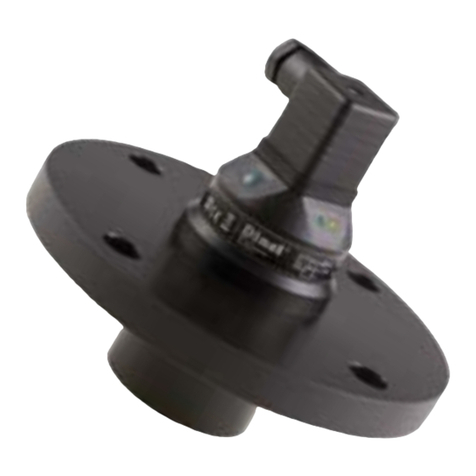
Dinel
Dinel ULM-53 series User manual

Dinel
Dinel CLM-36 User manual
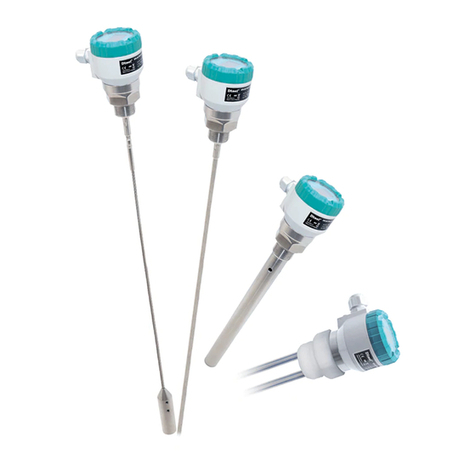
Dinel
Dinel CLM-70 User manual
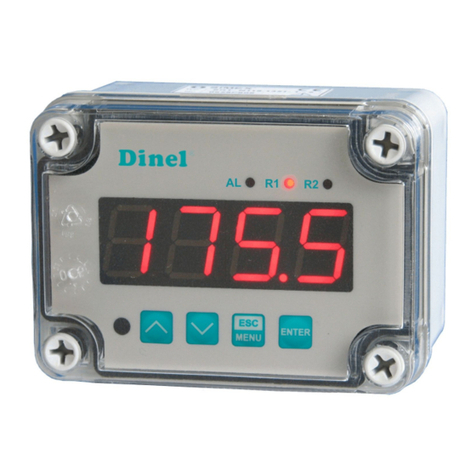
Dinel
Dinel PDU-40-W Series User manual
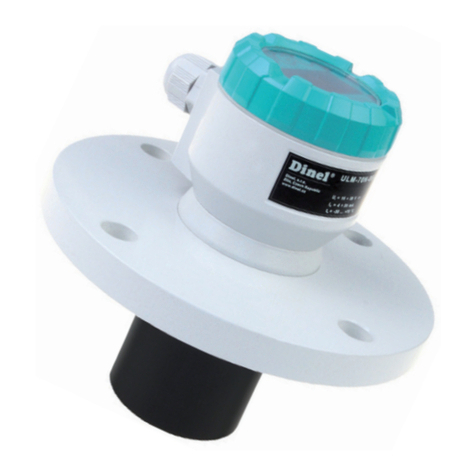
Dinel
Dinel ULM-70 Series User manual
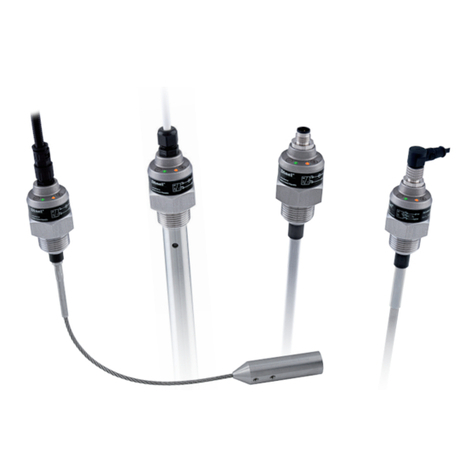
Dinel
Dinel DLM-35 User manual

Dinel
Dinel MLM-35 User manual
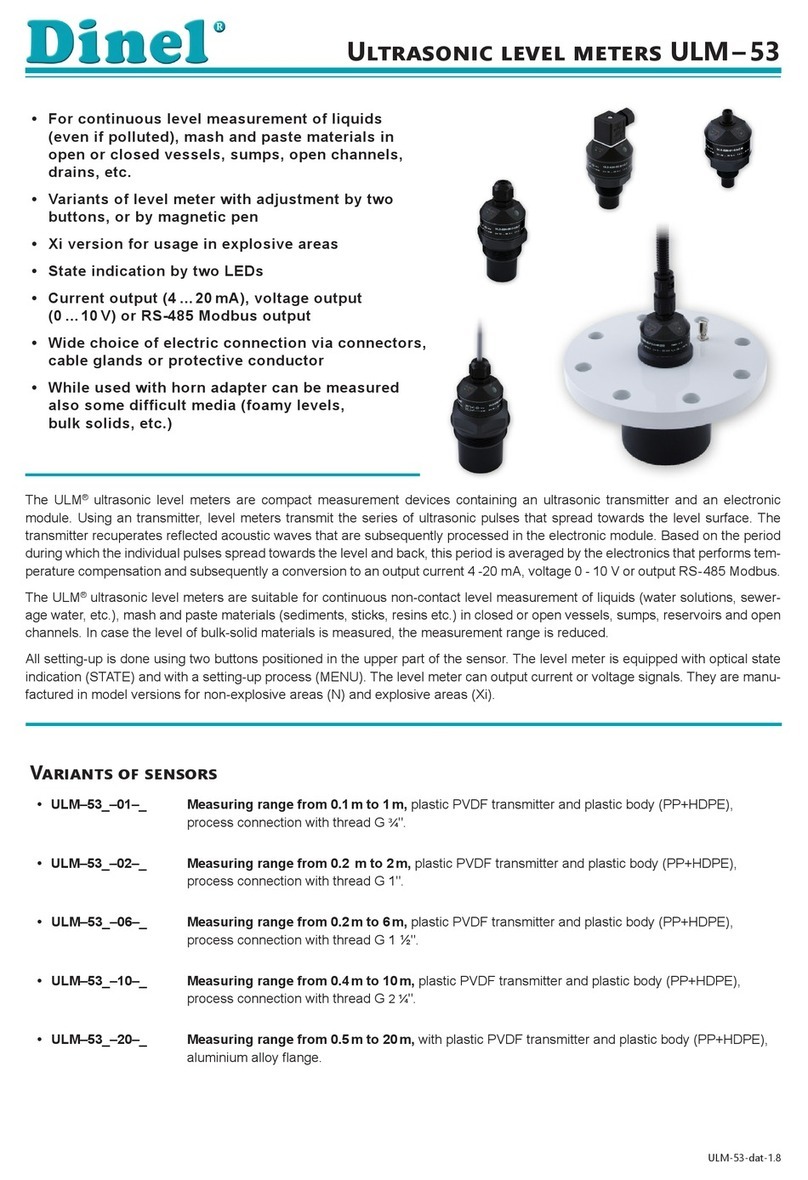
Dinel
Dinel ULM-53 series User manual

Dinel
Dinel ULM-53 series User manual

Dinel
Dinel ULM-53 series User manual
Popular Measuring Instrument manuals by other brands

PCE Health and Fitness
PCE Health and Fitness CMM 8 user manual
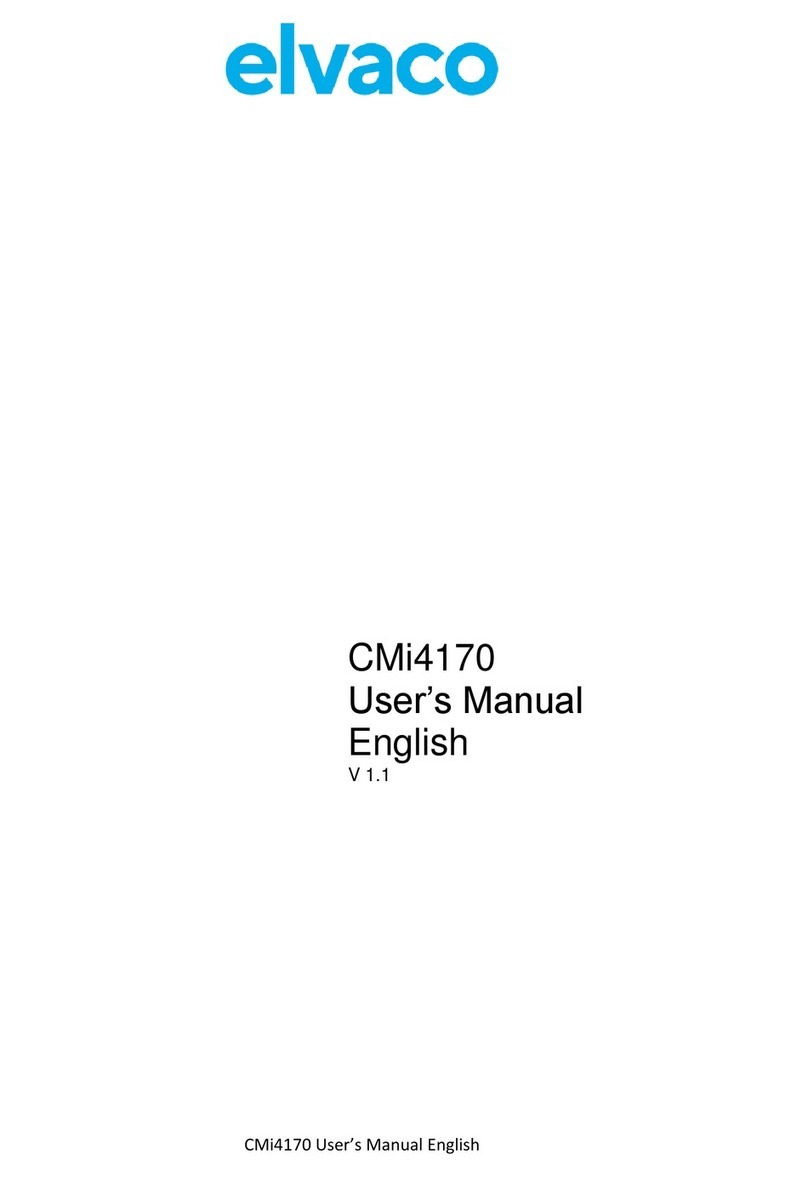
Elvaco
Elvaco CMi4170 user manual
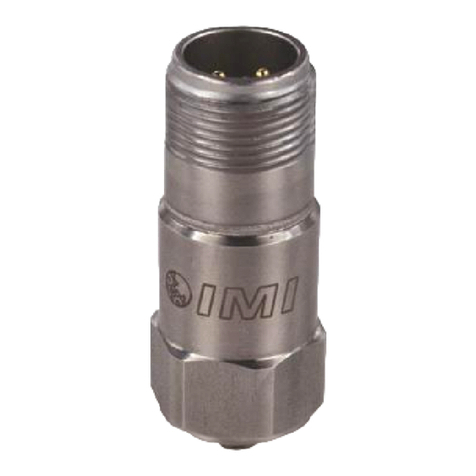
PCB Piezotronics
PCB Piezotronics IMI SENSORS M603M170 Installation and operating manual
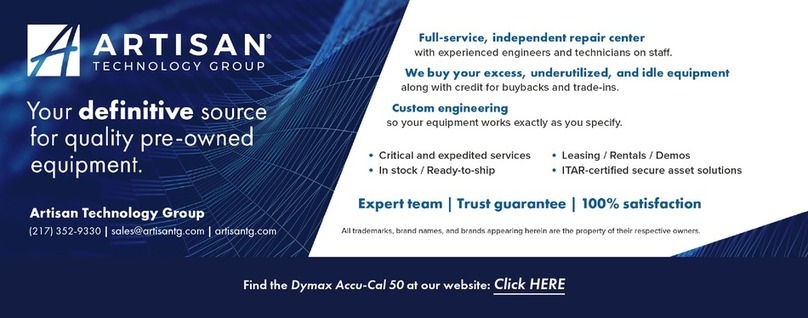
dymax
dymax Accu-Cal 50 user guide
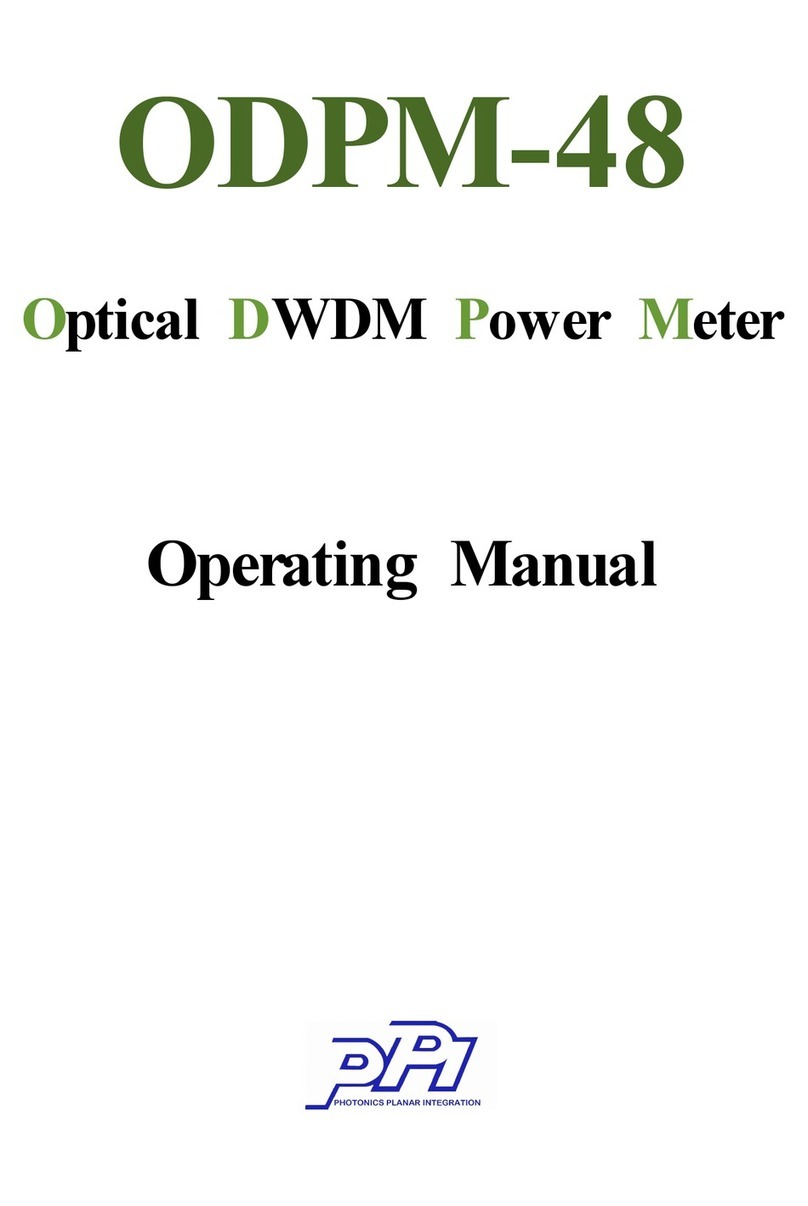
PPI
PPI ODPM-48 operating manual
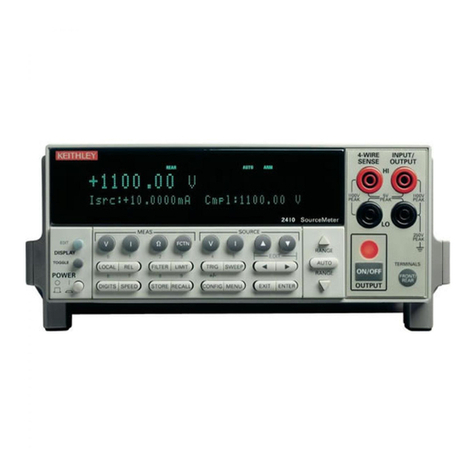
Tektronix
Tektronix Keithley SourceMeter 2410 Service manual
